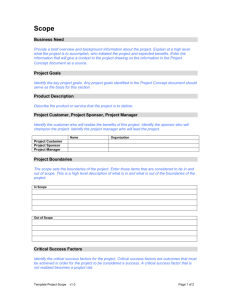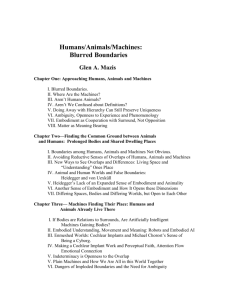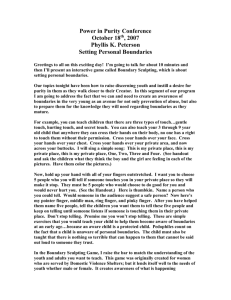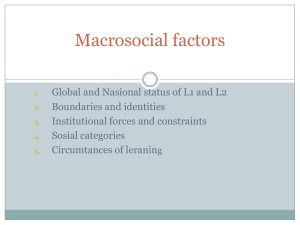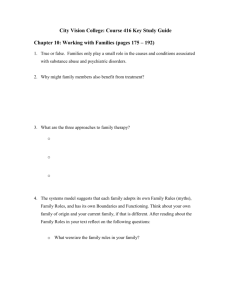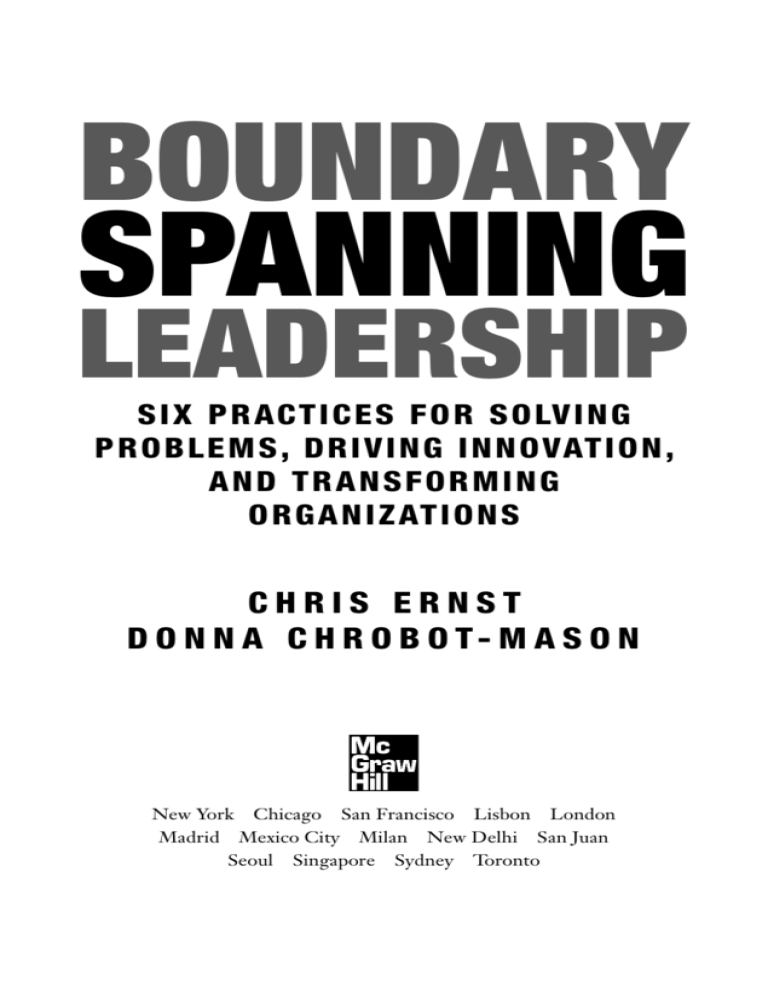
BOUNDARY
SPANNING
LEADERSHIP
S IX P R AC T I C E S F O R S O LV IN G
P ROBLEMS , D R I V I NG I NN OVAT IO N ,
A ND T R A NS F O R M IN G
O R GA NI Z AT I O N S
CHRIS ERNST
D O N N A C H R O B O T- M A S O N
New York Chicago San Francisco Lisbon London
Madrid Mexico City Milan New Delhi San Juan
Seoul Singapore Sydney Toronto
Copyright © 2011 by Chris Ernst and Donna Chrobot-Mason. All rights reserved. Except as
permitted under the United States Copyright Act of 1976, no part of this publication may be reproduced
or distributed in any form or by any means, or stored in a database or retrieval system, without the prior
written permission of the publisher.
ISBN: 978-0-07-170158-7
MHID: 0-07-170158-3
The material in this eBook also appears in the print version of this title: ISBN: 978-0-07-163887-6,
MHID: 0-07-163887-3.
All trademarks are trademarks of their respective owners. Rather than put a trademark symbol after
every occurrence of a trademarked name, we use names in an editorial fashion only, and to the benefit
of the trademark owner, with no intention of infringement of the trademark. Where such designations
appear in this book, they have been printed with initial caps.
McGraw-Hill eBooks are available at special quantity discounts to use as premiums and sales
promotions, or for use in corporate training programs. To contact a representative please e-mail us at
bulksales@mcgraw-hill.com.
This publication is designed to provide accurate and authoritative information in regard to the subject
matter covered. It is sold with the understanding that the publisher is not engaged in rendering legal,
accounting, or other professional service. If legal advice or other expert assistance is required, the
services of a competent professional person should be sought.
—From a Declaration of Principles Jointly Adopted by a Committee of the American Bar Association
and a Committee of Publishers and Associations
TERMS OF USE
This is a copyrighted work and The McGraw-Hill Companies, Inc. (“McGrawHill”) and its licensors
reserve all rights in and to the work. Use of this work is subject to these terms. Except as permitted
under the Copyright Act of 1976 and the right to store and retrieve one copy of the work, you may
not decompile, disassemble, reverse engineer, reproduce, modify, create derivative works based upon,
transmit, distribute, disseminate, sell, publish or sublicense the work or any part of it without McGrawHill’s prior consent. You may use the work for your own noncommercial and personal use; any other
use of the work is strictly prohibited. Your right to use the work may be terminated if you fail to comply
with these terms.
THE WORK IS PROVIDED “AS IS.” McGRAW-HILL AND ITS LICENSORS MAKE NO GUARANTEES OR WARRANTIES AS TO THE ACCURACY, ADEQUACY OR COMPLETENESS OF
OR RESULTS TO BE OBTAINED FROM USING THE WORK, INCLUDING ANY INFORMATION THAT CAN BE ACCESSED THROUGH THE WORK VIA HYPERLINK OR OTHERWISE,
AND EXPRESSLY DISCLAIM ANY WARRANTY, EXPRESS OR IMPLIED, INCLUDING BUT
NOT LIMITED TO IMPLIED WARRANTIES OF MERCHANTABILITY OR FITNESS FOR A PARTICULAR PURPOSE. McGraw-Hill and its licensors do not warrant or guarantee that the functions
contained in the work will meet your requirements or that its operation will be uninterrupted or error
free. Neither McGraw-Hill nor its licensors shall be liable to you or anyone else for any inaccuracy, error or omission, regardless of cause, in the work or for any damages resulting therefrom. McGraw-Hill
has no responsibility for the content of any information accessed through the work. Under no circumstances shall McGraw-Hill and/or its licensors be liable for any indirect, incidental, special, punitive,
consequential or similar damages that result from the use of or inability to use the work, even if any of
them has been advised of the possibility of such damages. This limitation of liability shall apply to any
claim or cause whatsoever whether such claim or cause arises in contract, tort or otherwise.
INTR ODUCTION
O
n the seventy-ninth floor of International Financial Group’s
(IFG) global headquarters in New York City, Paul Andrews
sits alone in a teleconference room. He has just wrapped up a meeting concerning one of IFG’s most ambitious projects in years: to
develop and deliver within six months a new financial service solution simultaneously across the Americas, Europe, and Asia. Minutes
ago, faces and voices representing five functions, three levels of
management, 11 countries, four suppliers, a customer panel, and
seemingly every type of human diversity imaginable were rendered
in nearly face-to-face precision across a wall-length screen.
Ambitious, talented, and experienced, IFG has identified the
team members and partners as the right people to develop and
deliver its innovative service, but at the moment, Paul wonders if
his dream team can overcome the rifts and divides he observed
during the meeting and how his leadership might enable better
쩥
1
쩥
B O U N D A RY S PA N N I N G L E A D E R S H I P
collaboration. He jots down some thoughts about how the disparate
groups are working together, both the positives and the negatives,
and notes the root causes of his concern:
Negatives
Rift—lack of trust between upper and middle
management.
Positives
Partnership—Asia senior and middle
management well coordinated. Shared
vision.
Collaboration—marketing and sales
well-linked. Lots of innovation potential.
Common ground—excellent feedback from
customer panel. Clear on the type of solution
they want us to deliver.
Engagement—willingness to share
wide-ranging perspectives. Diversity seen as
a strength.
Global mindset—high energy to develop global
solution. Commitment toward cross-regional
thinking.
Silos—R&D and operations not on same page. No
respect.
Turf battle—jockeying suppliers. They feel like
outsiders. No common purpose.
Generation gap—young team members love the
cutting edge technology, but old timers feel
threatened by it. Need safet y to overcome threat.
Culture clash—Europe lacks buy-in. They think
it’s just another US HQ project of the month.
Ownership lacking.
As Paul assesses the team, he realizes that even in a world of vast
collaborative potential, powerful and limiting boundaries surround
us. At IFG and in organizations and communities like yours, boundaries separate people into groups of Us and Them. These boundaries—some temporary, some deeply rooted—are built around both
vertical and horizontal structures as well as diverse stakeholder,
demographic, and geographic groups. Ideally, our organizations
and communities can harness the collaboration and innovation that
come from wide-ranging expertise, diverse experiences, and varied
identities. All too often, however, the boundaries are borders—
barriers that limit, confine, and lead to wasteful conflicts and
counterproductive divides.
쩥
2
쩥
INTRODUCTION
The word boundary has two very different meanings.
bound-a-ry
1. something that indicates bounds or limits; a border or
bounding line
2. Also called frontier. The location of the most advanced or
newest activity in an area
—Random House Dictionary, 2009
In this book, we explore the notion that boundaries can be experienced in organizations and broader communities as two very different things. Boundaries may be borders that limit human potential,
restrict creativity and innovation, and stifle necessary business and
societal change. But boundaries also may represent frontiers: the
location where the most advanced thinking and breakthrough possibilities reside. What explains the difference between limiting
borders and limitless frontiers? In a word, leadership.
In navigating today’s unfamiliar terrain, we are all challenged to
think and act beyond the current borders that confine us, our teams,
and our organizations as a whole. Developing innovative solutions
requires reaching beyond present boundaries and seeking new
frontiers at the nexus where groups collide, intersect, and link.
Like Paul at IFG, many of us—senior executives, directors, plant
managers, community organizers—are at a loss about how to think
and act in today’s shifting leadership landscape. The challenges of
boundaries call forth a need for new ways to bring groups together
and, yes, new ways to practice leadership.
Boundary spanning leadership is composed of six practices
for leading at the nexus between groups: buffering, reflecting,
쩥
3
쩥
B O U N D A RY S PA N N I N G L E A D E R S H I P
connecting, mobilizing, weaving, and transforming. Through these
practices you will be able to transform borders into new frontiers to
solve problems, create innovative solutions, and evolve and transform your organization to thrive in a flat world.
In so doing, you will be rewarded with new possibilities and
inspiring results, including the following:
• Increased organizational agility to respond to a dynamic
marketplace
• Advanced cross-organizational innovation processes
• Achievement of mission-critical bottom-line results
• An engaged and empowered workplace at all levels
• Flexible, cross-functional learning capabilities to solve problems
and adapt to change
• A welcoming, diverse, and inclusive organization that brings out
everybody’s best
• New abilities to work in deeper, more open relationships with
customers
• Better-managed risks and rewards through enduring
cross-sector partnerships
• Well-integrated merged or acquired organizations
• A more socially responsible organization
• Higher-performing virtual teams
• Global mindsets and cross-regional collaboration
• Improved capacity to create shared direction, alignment, and
commitment throughout the organization
Realizing these and other inspiring results is not just an ideal but
an essential business reality. A new approach to leading across
쩥
4
쩥
INTRODUCTION
vertical, horizontal, stakeholder, demographic, and geographic
boundaries is needed. We call this new approach boundary spanning
leadership.
An Introduction to Boundary Spanning Leadership
Boundary spanning leadership is the ability to create direction, alignment,
and commitment across boundaries in service of a higher vision or goal.1, 2
By employing the six leadership practices, you create direction,
alignment, and commitment between groups to achieve critical
organizational outcomes. These practices reside within the interactions across groups, teams, functions, units, organizations, and
broader communities. As a boundary spanning leader, your job is to
build a bridge and your role within that job is to provide the space
for these practices to occur. Figure I.1 shows an example.
Figure I.1 Boundary spanning leadership.
R&D
Operations
Direction
Alignment
Commitment
New Financial Solution
Paul Andrews
쩥
5
쩥
B O U N D A RY S PA N N I N G L E A D E R S H I P
At IFG, Paul Andrews’s task is to bring together multiple functional, regional, and stakeholder groups to develop a new financial
service solution. A simplification of these relationships is illustrated
in the figure. First, the diagram illustrates two groups, R&D and
Operations (we left out all the other groups to keep things simple).
Second, these groups need to collaborate to achieve a higher vision
or goal: the creation of a new financial service. However, this won’t
be easy. These two functions operate as silos, with little respect
or trust between them. To achieve the goal, Paul needs to span
boundaries to create effective leadership across groups. In our
research and practice at the Center for Creative Leadership (CCL),
we define leadership in terms of accomplishing three outcomes:
• Direction: a shared understanding of common goals and strategy
• Alignment: the joint coordination of resources and activities
• Commitment: a commitment to collective success that is equal to
or above the commitment to the unique success of any single
group3
We hope you can appreciate the complexities of boundary spanning leadership in this simple example. In this case, generating
increased direction, alignment, and commitment across two divergent functions—R&D and Operations—is challenging enough.
Achieving that goal becomes even more daunting when you find
yourself stuck in the middle of multiple groups and boundaries
simultaneously. To put it bluntly, when you are leading in the middle between groups, the days of “I lead and you follow” are over.
Gone are the days when leaders work within an intact group in
which leaders and followers share a culture, values, and interests.
쩥
6
쩥
INTRODUCTION
Instead, today you must lead across groups, at the juncture where
wide-ranging experience, diverse expertise, and varied identities intersect. It is here at the intersection where two powerful human forces—
differentiation and integration—collide that you can enact the six
boundary spanning practices to catalyze collaboration, drive innovation, and transform your organization. Shortly, we describe more
fully the six leadership practices you need to make that happen.
But first a few words about the organization of this book, a preview of what you’ll find in these pages, and a model of boundary
spanning leadership that pulls the main ideas together.
Book Overview
Part 1: The Forces That Pull Us Apart and Bring
Us Together
The landscape beneath your feet is shifting dramatically. Advancing
technology, changing global demographics, and expanding globalization are dismantling boundaries in organizations around the
world rapidly. In Chapter 1, we explore how you will need to think
and act differently across five types of boundaries: vertical, horizontal, stakeholder, demographic, and geographic. We’ll also walk you
through an activity to identify your own unique Nexus Challenge
and return to it at points throughout the book as a means for you to
apply the book’s concepts to your own organization.
After providing an orientation to the five types of boundaries
found in today’s landscape, we focus on you and your unique identity as a leader in Chapter 2. You’ll have a chance to “map” your
identity: the unique attributes, characteristics, skills, and interests
쩥
7
쩥
B O U N D A RY S PA N N I N G L E A D E R S H I P
that make you you. You’ll come to see how identities are formed out
of the interplay between two fundamental, universal, and powerful
human forces: the need for differentiation, divergence, and uniqueness and the need for integration, convergence, and belonging.
This most basic of human needs to establish a positive identity—to
simultaneously belong and to be unique—provides the science on
which the ideas in this book are based.4
In Chapter 3, we apply what you learned about identity to demonstrate the unfortunate but all too real potential for destructive
Great Divides—the limited and counterproductive outcomes that occur
when groups divide into Us and Them. As technical and structural
boundaries are dismantled in an “ever-flattening” world, the boundaries that remain in human relationships paradoxically become
sharper and more jagged. The boundaries that matter most today
are psychological and emotional rather than organizational and
structural. Great Divides between Us and Them are about identity:
our core values, how we define ourselves, and our beliefs concerning how we fit within our social world. Paul Andrews didn’t attribute the root cause of the rifts and divides he observed in his team
to systems, structures, or technology. He attributed them to the
deeper dynamics found in human relationships: lack of trust, no
respect, no common purpose, the need for safety to overcome
threat, lack of ownership. There’s no quick fix or technical solution
for any of these problems: They address not what people do or
how they do it but who they are.
To bridge, span, and reach across such complex boundaries in
human relationships, you must learn to do three things: manage
boundaries, forge common ground, and discover new frontiers.
This is the core of the book and our focus in Parts 2, 3, and 4.
쩥
8
쩥
INTRODUCTION
Part 2: Managing Boundaries
A boundary demarcates where one thing stops and another starts.
To manage boundaries is to define and understand what differentiates groups. Ultimately, this book is about how you can bring groups
together to achieve inspiring results. The first step to spanning
boundaries is, ironically, to create or strengthen them. You must be
able to see group boundaries clearly before you can bridge them. In
Part 2, we describe the two practices—buffering and reflecting—
that enable you to manage the boundaries between groups.
The practice of buffering involves defining boundaries to create
safety between groups. Buffers monitor and protect the flow of information and resources across boundaries. To see buffering in action,
we will visit South Africa in Chapter 4 and learn how Joe Pettit and
Zanele Moyo worked together to manage the boundary that still
exists between blacks and whites in a postapartheid organization.
Once groups have achieved a state of safety between them, the
next practice, reflecting, involves understanding boundaries to foster
intergroup respect. Reflectors represent distinct perspectives and
facilitate knowledge exchange across groups. In Chapter 5, we’ll go
to Chatham County, North Carolina, to witness the incredible transformation that occurred within Rick Givens and ultimately within
the community he led. Through his own inner journey, Givens used
the practice of reflecting to become a boundary spanning leader.
What if your organization and your broader community were
places of unconditional positive regard, psychological safety, and
mutual respect across vertical, horizontal, stakeholder, demographic, and geographic boundaries? What new opportunities
would arise? With this foundation in place, you are ready to move
쩥
9
쩥
B O U N D A RY S PA N N I N G L E A D E R S H I P
forward and upward, to go beyond managing boundaries and toward
forging common ground.
Part 3: Forging Common Ground
Common ground represents what is universal and shared. To forge
common ground is to bring groups together to achieve a larger purpose. Recall that the human need for uniqueness is balanced by an
equally powerful need for belonging. In Part 3, we describe two
practices—connecting and mobilizing—that enable you to tap into
the human need to be part of something larger than yourself.
The practice of connecting involves suspending boundaries to build
trust between groups. Connectors link people and bridge divided
groups across boundaries. To witness connecting in action, we’ll go
to Europe in Chapter 6 and see how Daniel Sutton successfully led
a cross-sector task force by building trust across three divergent
groups—energy executives, environmentalists, and government
leaders—to develop a new, more sustainable plan for their city.
Once the boundaries between groups fade into the background,
the next practice, mobilizing, involves reframing boundaries to
develop intergroup community. Mobilizers craft common purpose
and shared identity across boundaries. History was made in 2005
when the Chinese computer company Lenovo announced that it
had purchased IBM’s global personal computer operation. In
Chapter 7, we’ll learn how leaders at Lenovo are bridging boundaries between East and West by building community in their quest to
create the world’s most innovative PCs.
What if your organization and broader community were places
of mutual trust, community, and collective action where groups
쩥
10
쩥
INTRODUCTION
collaborated skillfully across vertical and horizontal structures, along
with disparate stakeholder, demographic, and geographic groups?
What new avenues for creativity and innovation would come into
view? Connecting and mobilizing are the next practices in boundary
spanning leadership. You are now ready to go further yet, moving
beyond forging common ground to discovering new frontiers.
Part 4: Discovering New Frontiers
A frontier is a place of emergent possibility. It represents the outer
limits, the location where the most advanced and breakthrough
thinking resides. The frontier is where both of the powerful human
forces—differentiation and integration—intersect in transformative
new ways. In Part 4, we explore the final two practices—weaving
and transforming—that enable you to discover new frontiers where
similarities and differences meet.
Weaving occurs when boundaries are interlaced in new ways to
advance intergroup interdependence. Weavers draw out and integrate
group differences within a larger whole. In Chapter 8, we’ll travel to
India to observe how the CEO of the nonprofit organization Child
Relief and You (CRY) used the practice of weaving to lead a wildly
successful strategic change in support of the organization’s mission.
Once groups have achieved a state of interdependence, the final
practice, transforming, involves cross-cutting boundaries to enable
intergroup reinvention. Transformers bring multiple groups
together in new directions to realize emergent possibilities. The
issue of energy sustainability represents perhaps the most critical
boundary spanning dilemma of our time. In Chapter 9, we’ll see
how Mark Gerzon, one of the world’s foremost authorities on
쩥
11
쩥
B O U N D A RY S PA N N I N G L E A D E R S H I P
intergroup leadership, is cross-cutting boundaries to create an
alternative future that is distinctly different from the present.
What if your organization and broader community were places
of interdependent collaboration, collective learning, and positively
transformative change? What alternative futures could be created
to thrive and adapt in an ever-changing world?
Part 5: The Nexus Effect
In the final section of the book, we bring all the pieces together. In
Chapter 10, we encourage you to put the ideas in this book into action.
We’ll do this by sharing the remarkable story of John Herrera and by
illustrating the Nexus Effect: the limitless possibilities and inspiring results
that groups can realize together above and beyond what they can achieve on
their own. You’ll see how John was able to tap into the power of the
Nexus Effect by using the six boundary spanning leadership practices
to create the Latino Community Credit Union, the fastest-growing
credit union in the country. It has far exceeded anyone’s expectations,
but it took a collective vision and the collaborative effort of many
community leaders working across boundaries to make it happen.
Finally, in the Epilogue we take a look ahead. Through tremendous advances in communication and transportation technologies,
the scale of human interaction now encompasses the globe. Yet it is
also true that our potential for collaboration remains largely unrealized. The real-world stories throughout this book are regrettably
the exception rather than the rule; they are about ordinary leaders
achieving extraordinary things at the nexus between groups. In the
Epilogue, we return to their stories one final time to consider the
possibilities for a more interdependent, collaborative future.
쩥
12
쩥
INTRODUCTION
We welcome you to the book and the exciting places we’ll go. To
navigate today’s shifting leadership landscape, there’s never been a
more urgent need for boundary spanning leadership.
Boundary Spanning Leadership Model
By using six boundary spanning practices, leaders can transform the
limited and counterproductive outcomes of a Great Divide into the
limitless possibilities and inspiring results of the Nexus Effect. The
boundary spanning model shown in Figure I.2 illustrates the upward
Figure I.2 The six practices of boundary spanning leadership.
쩥
13
쩥
B O U N D A RY S PA N N I N G L E A D E R S H I P
spiral leaders must travel to increase intergroup collaboration. This
spiral depicts how leaders progress from managing boundaries, to
forging common ground, to discovering new frontiers at the nexus
between groups. Through the six boundary spanning practices,
leaders create a Nexus Effect to solve problems, create innovative
solutions, and transform their organizations.
쩥
14
쩥


